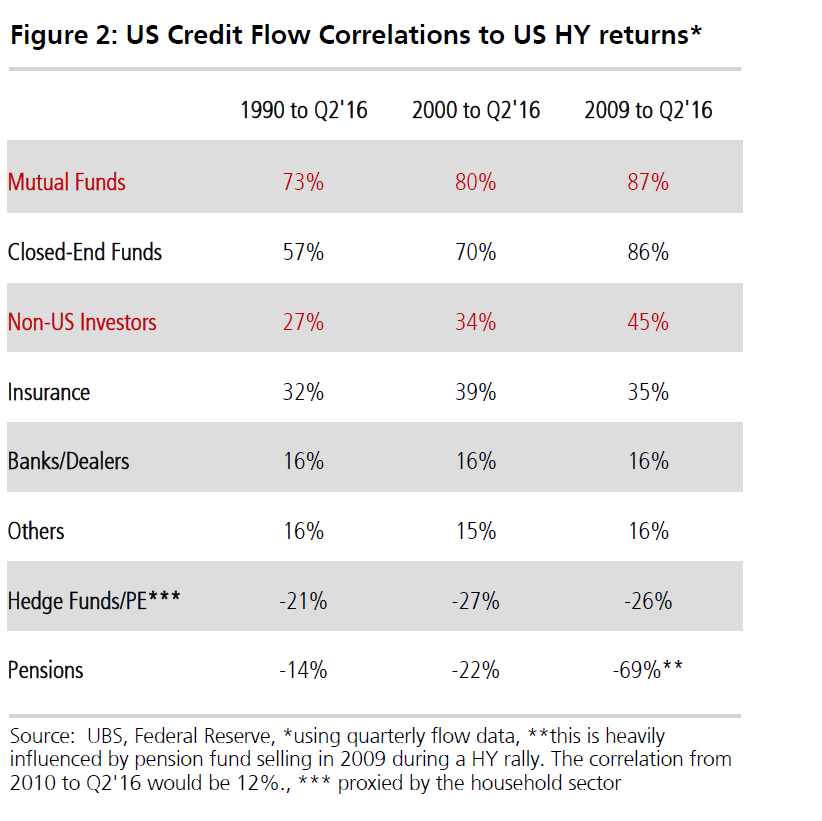by Sid Verma
(Bloomberg) --Here’s another chart to scare you this Halloween: Foreign investors, who now represent 39 percent of funds dedicated to the U.S. high-yield fixed-income market, have become ever-more sensitive to the asset class’s performance since the financial crisis.
This dynamic—combined with rising allocations from mutual funds beset with liquidity mismatches—raises the prospect of volatile price swings if the credit cycle turns, according to a report this week from analysts at UBS Group AG.
Led by Stephen Caprio, they warned that both non-U.S. funds and mutual-fund flows are increasingly correlated with returns, which is a way to gauge any appetite for credit risk.
“The problem is that both mutual funds and non-U.S. accounts were near the most aggressive sellers of credit during the 2008 crisis. And it is not only a financial crisis that initiates this behavior. Figure 2 highlights that the demand function of mutual funds, ETFs, and non-U.S. investors is most correlated to credit risk. Hence, while measures of liquidity such as bid-ask spreads remain benign, the tail risk of market illiquidity is still real.”

With 57 percent of short-duration U.S. high-yield funds owned by non-U.S. investors, new market conditions—specifically, the structural rise of more fickle investors in the U.S. credit market, particularly at the short end of the yield curve—sow the seeds of potential disruption, the analysts conclude:
“Funds are more likely to sell bonds than dip into cash reserves to meet redemptions when the next legs of risk aversion hit. Hence, the increased fund ownership of credit today has the potential to re-price spreads more quickly in both directions going forward.”
Wells Fargo & Co. in July calculated that foreign investors had increased their ownership of U.S. corporate debt by around 5 percentage points over the year, to 40 percent, with European investors—starved of yields in domestic markets—representing 80 percent of that international contingent, though the U.S. investment-grade market has benefited more than its higher-yield counterpart.
The strength of the dollar has whittled returns for currency-hedged foreign investors in recent months, triggering a slowdown in flows into U.S. corporate debt, particularly from Japanese investors in recent weeks. On Thursday, outflows from the iShares iBoxx High Yield Corporate Bond exchange-traded fund (HYG), the top ranked ETF by assets in the junk bond market, reached a record $1 billion, amid rising fears of interest-rate risk.
While valuations in the U.S. corporate debt market might look rich relative to fundamentals, the asset class’s attractive liquidity profile and the prospect of a yield pickup relative to comparable debt in Europe and Japan should continue to buoy foreign investor flows, according to Nathaniel Rosenbaum, a credit strategist at Wells Fargo Securities.
While a Fed rate hike in December would increase FX-hedging costs, Rosenbaum says a positive growth shock in Europe and Japan might pose the biggest risk in reducing foreign demand for U.S. credit. He told Bloomberg in a phone interview:
“Convergence of central-bank policies is the biggest risk in terms of foreign buyers withdrawing from U.S. credit. Convergence could occur if the Fed adopts dovish policies to counteract a U.S recession, or conversely if growth picks up in Europe and Japan, leading central banks there to adopt more Fed-like hawkish policies. We believe the risks are asymmetric because in the former situation, dollar yields would be falling and counteract some of the FX losses from dollar weakness. Whereas in the latter scenario, yields would rise alongside a fall in the dollar, therefore amplifying potential losses for foreign investors.”

To contact the author of this story: Sid Verma in London at [email protected] To contact the editor responsible for this story: David Rovella at [email protected]

